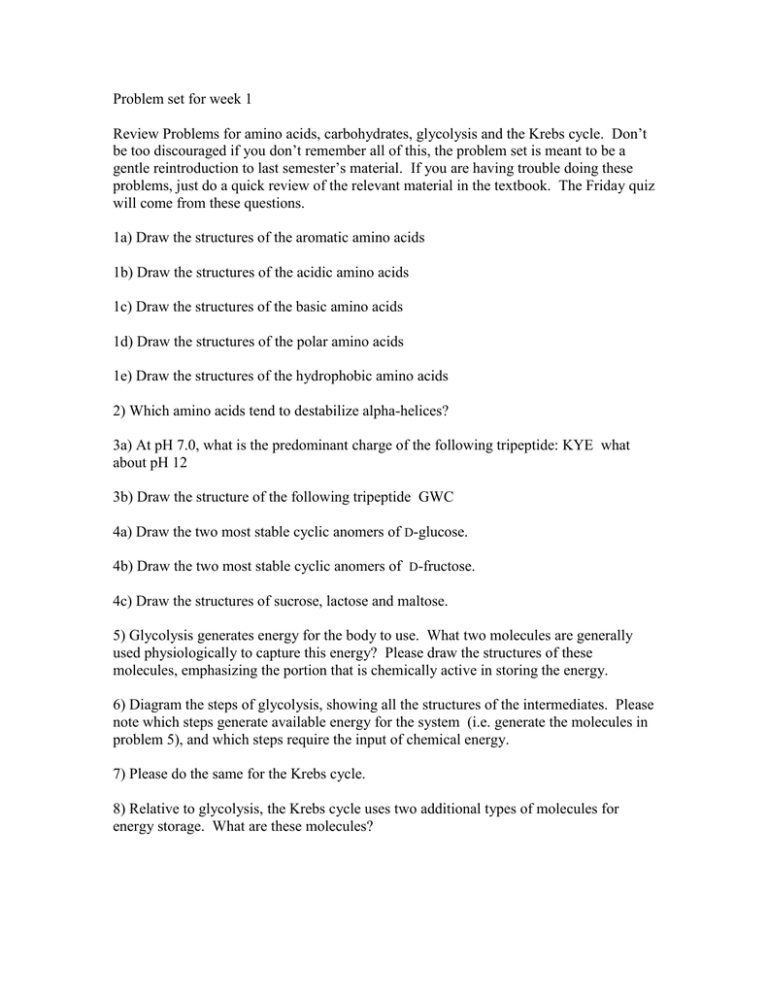Problem set 1 (week one)
advertisement

Problem set for week 1 Review Problems for amino acids, carbohydrates, glycolysis and the Krebs cycle. Don’t be too discouraged if you don’t remember all of this, the problem set is meant to be a gentle reintroduction to last semester’s material. If you are having trouble doing these problems, just do a quick review of the relevant material in the textbook. The Friday quiz will come from these questions. 1a) Draw the structures of the aromatic amino acids 1b) Draw the structures of the acidic amino acids 1c) Draw the structures of the basic amino acids 1d) Draw the structures of the polar amino acids 1e) Draw the structures of the hydrophobic amino acids 2) Which amino acids tend to destabilize alpha-helices? 3a) At pH 7.0, what is the predominant charge of the following tripeptide: KYE what about pH 12 3b) Draw the structure of the following tripeptide GWC 4a) Draw the two most stable cyclic anomers of D-glucose. 4b) Draw the two most stable cyclic anomers of D-fructose. 4c) Draw the structures of sucrose, lactose and maltose. 5) Glycolysis generates energy for the body to use. What two molecules are generally used physiologically to capture this energy? Please draw the structures of these molecules, emphasizing the portion that is chemically active in storing the energy. 6) Diagram the steps of glycolysis, showing all the structures of the intermediates. Please note which steps generate available energy for the system (i.e. generate the molecules in problem 5), and which steps require the input of chemical energy. 7) Please do the same for the Krebs cycle. 8) Relative to glycolysis, the Krebs cycle uses two additional types of molecules for energy storage. What are these molecules? 9) Review your redox chemistry. On the following page are some common biological half reactions. Going in the forward direction, please note if they are reductions, oxidations, or neither- and state the number of electrons involved in the transformation. 8) Now some harder ones… 1) 2) 3) 4) 5) 6) 10) A thought problem just for fun. (This will NOT be on your quiz, but is worth thinking about.) Consider the following explanation (from Web MD) of lactic acidosis, a condition that arises during vigorous anaerobic exercise. “Lactic acidosis occurs naturally when lactic acid, a byproduct of metabolism, builds up in muscles and blood during vigorous exercise. Lactic acidosis due to exercise leads to muscle ache and fatigue, but is temporary and is usually not harmful” Please think about the following: 1- Is lactic acid actually the product of anaerobic glycolysis in mammals? If not, what is? (there are actually two major compounds formed, one of which you should know). 2- Is this compound an acid, or a base? 3- The normal end point of glycolysis is the formation of pyruvate. This is not the case under conditions of anaerobic exercise- why not? (Consider the various fates of pyruvate produced by glycolysis.) 4- Does the production of pyruvate normally produce protons? What happens to these protons under anaerobic conditions? 5-Given that lactic acidosis does occur during anaerobic exercise, what process do you think might be responsible for the production of acid? 6- What is the actual source of muscle fatigue in vigorously working muscles?

